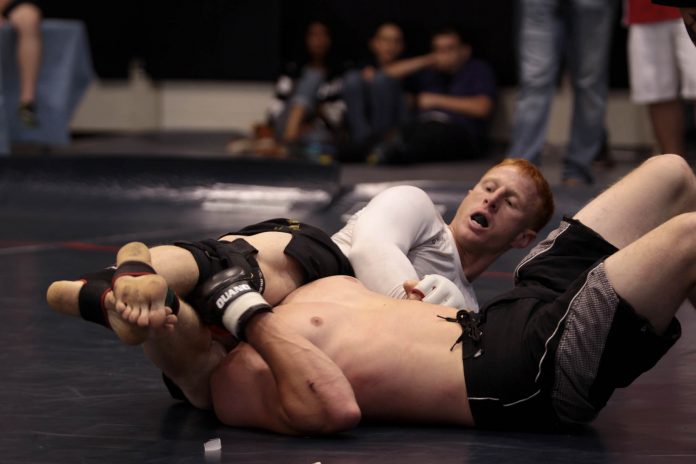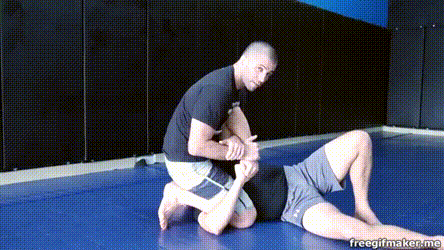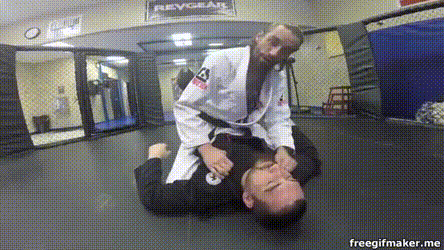
When we talk about Jiu-Jitsu chokes there is a real danger of getting lost in the subject. There’s simply no other grappling martial art out there that has as much diversity in the area of choking people out as Brazilian Jiu-Jitsu. From the quintessential guillotine and Rear Naked Chokes to intricate lapel chokes from weird positions, you’ll see it all in BJJ. However, there’s clear favoritism towards certain chokes. Although they have proven to be effective throughout the years and in multiple competition formats, it is good to take a break and explore some other aspects of strangling people every once in a while. Today, we’ll look at two underused, yet astonishingly effective chokes that’ll catch everyone you meet by surprise!
The most satisfying tap in BJJ doesn’t come from an arm or leg lock. Yes, hitting a heel hook from the Inside Senaku is rewarding but it’s not as much of an undisputed victory as choking someone. Jiu-Jitsu chokes have the power of ending someone’s life and it requires surprisingly little force. Given that you know how to perform it, of course. A person tapping to a choke acknowledges that you could’ve taken their lives at will. It is the ultimate surrender and the most satisfying manner of winning.
Furthermore, Jiu-Jitsu chokes are the one move that works on anybody. No matter the size, strength or flexibility of a person if you get into a position to catch a choke it’s over. Whether you go for a blood choke and finish things in seconds or torture someone with an air choke the result is the same. the only trouble is, that people that also train BJJ are well versed at defending and countering choke attacks. to that extent, there are moves that’ll surprise even the most seasoned black belts. In fact, one of the chokes we’re going to cover today was a favorite of Helio Gracie himself. That’s as big of a statement on its efficacy as there’s one.
Mixing It up With Jiu-Jitsu Chokes
As previously mentioned, most chokes in Brazilian Jiu-Jitsu work in one of two ways. The most common, and more reliable method of strangling someone is via a blood choke. That involves blocking the blood flow of the carotid arteries on both sides of the neck. NO blood means no oxygen to the brain, which, in turn, means going to sleep.
The second manner of choking people is via an air choke. A great example is eh Guillotine choke 9lthough it can double as a blood choke two). With an air choke, yo disrupt the airflow by blocking the trachea with direct pressure. They also work very effectively but take more time and are much more painful than the surgical blood chokes.
Today’s unusual choking techniques come in each of the above-described varieties. These chokes do not feature as regularly in BJJ anymore, for one reason or another. Perhaps they’ll have a resurgence sometime in the future, or stay in the shadows for time to come. Who knows. What I know for sure is that they work, both in training and competition and against all kinds of opponents. Nope, they’re not the ultimate chokes that’ll work 100 % of the time. They’re just a different and really simple way of getting a tap via an unusual technique. they’re also legal at every level of BJJ and work both in Gi and No-Gi.
Increase your choking arsenal with the help of the Aussie that knows all about chokes! Lachlan Giles can teach you everything you need to know about chokes for BJJ in his High Percentage Chokes. And also Alexandre Vieira with his Crucifix and Loop Choke Instructional. It’s the best and most detailed instructional on Loop Choke and Crucifix ever.
The Nutcracker Choke
I’ve heard people refer to this one as an old wrestling choke that doesn’t work in BJJ. I, personally, beg to differ. I re-discovered this one a short while ago and it refreshed my submission game significantly.
First and foremost, who can aim to use this choke? To tell you the truth, I’d recommend it to people from the blue belt onwards. The reason is that it involves a Kimura grip which, in itself, requires a certain level of technical knowledge. In terms of the mechanics of the choke, this one is an air choke.
Basically, the picture that you have a Kimura on someone from a north-south position. This is a very usual position of attacking the Kimura lock. It is also a very usual thing for an opponent to defend stubbornly, by holding on to their belt or leg. This prevents the Kimura submission but provides an anchor point for the nutcracker choke. To get the choke, you need to lie to the side of the arm you’re attacking. The idea is that you’re lying on the shoulder of the second arm in the figure four grip.

The Grapefruit Choke
First of all, credit where credit is due. I learned this choke as a white belt from Jungle BJJ founder and black belt Fernando Araujo He referred to it as the Helio Gracie choke, and later on I found it cited as the Grapefruit choke as well. Apparently, Grandmaster Helio Gracie used this choke very often and to great success. Personally, I’ve gotten two wins via this choke in competition, so I can say that it works for me. People that I’ve shown it to have also used it successfully when fighting.

What I found out in No-Gi is that it is way easier for someone to slip out since there’s no Gi to anchor on. So, when finishing the choke in No-Gi, aim to place both elbows firmly on the ground with the choke ready to go. Then, use your head to further stabilize your position and twist your fists, first towards yourself and then towards the mats. AS far as Jiu-Jitsu chokes go it doesn’t get simpler than this. Nor more effective!


![Darce Choke Encyclopedia – Origins, Mechanics and Variations [2025] BJJ, choke, Brabo, BJJ Darce Choke, D'arce Choke, Darce BJJ Choke](https://bjj-world.com/wp-content/uploads/2017/11/JungPoirierLeeYahoo-218x150.jpg)









![Countering with Crab Ride Anthony Budion DVD Review [2025] Countering with Crab Ride Anthony Budion DVD Review](https://bjj-world.com/wp-content/uploads/2025/03/countering-with-crab-ride-anthony-budion-dvd-review-218x150.png)
![Closet Closed Guard Craig Jones DVD Review [2025] Closet Closed Guard Craig Jones DVD Review](https://bjj-world.com/wp-content/uploads/2025/03/closet-closed-guard-craig-jones-dvd-review-218x150.png)
![Xanadu Back Takes Levi Jones-Leary DVD Review [2025] Xanadu Back Takes Levi Jones-Leary DVD Review](https://bjj-world.com/wp-content/uploads/2025/03/xanadu-back-takes-levi-jones-leary-dvd-review-218x150.png)

![No-Gi Grapplers Guide To Front Headlock Joel Bane DVD Review [2025] No-Gi Grapplers Guide To Front Headlock Joel Bane DVD Review](https://bjj-world.com/wp-content/uploads/2025/03/no-gi-front-headlock-joel-bane-dvd-review-218x150.png)




![Baseball Chokes From Everywhere Magid Hage DVD Review [2025] Baseball Chokes From Everywhere Magid Hage DVD Review](https://bjj-world.com/wp-content/uploads/2025/01/baseball-chokes-from-everywhere-magid-hage-dvd-review-100x70.png)



![Advanced Chin Control Concepts David Petrone DVD Review [2025] Advanced Chin Control Concepts David Petrone DVD Review](https://bjj-world.com/wp-content/uploads/2025/01/chin-control-concepts-david-petrone-dvd-review-100x70.png)
![BJJ Foundations Mikey Musumeci DVD Bundle Review [2024] BJJ Foundations Mikey Musumeci DVD Bundle Review](https://bjj-world.com/wp-content/uploads/2024/09/bjj-foundations-mikey-musumeci-dvd-bundle-review-100x70.png)
![Collar Sleeve Guard Mikey Musumeci DVD Review [2024] Collar Sleeve Guard Mikey Musumeci DVD Review](https://bjj-world.com/wp-content/uploads/2024/12/collar-sleeve-guard-mikey-musumeci-dvd-review-100x70.png)
![Weight Training For Grappling Michael Israetel DVD Review [2025] Weight Training For Grappling Michael Israetel DVD Review](https://bjj-world.com/wp-content/uploads/2025/01/weight-training-for-grappling-michael-israetel-dvd-review-100x70.png)
![Flow Pressure Kauan Barboza DVD Review [2025] Flow Pressure Kauan Barboza DVD Review](https://bjj-world.com/wp-content/uploads/2025/02/flow-pressure-kauan-barboza-dvd-review-100x70.png)




![Gracie Secrets Closed Guard Kyra Gracie DVD Review [2024] Gracie Secrets Closed Guard Kyra Gracie DVD Review](https://bjj-world.com/wp-content/uploads/2024/12/closed-guard-kyra-gracie-dvd-review-100x70.png)






![Leg Lock Strategies: Navigating Entanglements Jack Stapleton DVD Review [2024] Leg Lock Strategies: Navigating Entanglements Jack Stapleton DVD Review](https://bjj-world.com/wp-content/uploads/2024/12/navigating-entanglements-jack-stapleton-dvd-review-100x70.png)

![Dynamic Headquarters Passing Jason Rau DVD Review [2024] Dynamic Headquarters Passing Jason Rau DVD Review](https://bjj-world.com/wp-content/uploads/2024/10/dynamic-headquarters-passing-jason-rau-dvd-review-100x70.png)
![Back Control and Submission Felipe Pena DVD Reveiw [2025] Back Control and Submission Felipe Pena DVD Reveiw](https://bjj-world.com/wp-content/uploads/2025/01/back-control-and-submission-felipe-pena-dvd-reveiw-100x70.png)

